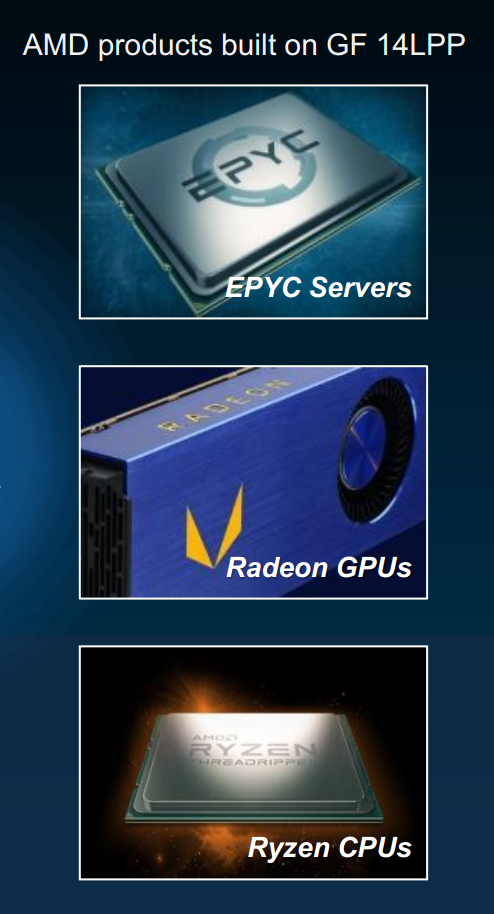From its annual tech conference last week (Sept. 20), where GlobalFoundries welcomed more than 600 semiconductor professionals (reaching the Santa Clara venue’s max capacity and doubling 2016 attendee numbers), the one-of-four foundry business launched a raft of announcements, including a new 12nm FinFET process for high performance applications. Prominent customer Advanced Micro Devices will use the 12nm technology in its Ryzen CPUs and Vega GPUs, bolstering its competitiveness against Intel and Nvidia.
GlobalFoundries said the new 12nm platform, on track for risk production in the first half of 2018, will offer a 15 percent improvement in circuit density and a greater than 10 percent performance boost over industry 16nm FinFET solutions. (There’s an intended improvement over 14nm too, of course, but no specific figures were offered.) Manufactured at the GlobalFoundries’ Fab 8 factory in Malta, NY, 12LP (LP stands for Leading Performance) builds on GloFo’s 14nm FinFET platform in high-volume production since early 2016.
“It pushes new design rules and some new constructs,” said GlobalFoundries CEO Sanjay Jha, “but our fundamental focus is to enable people who have already designed 14nm to be able to migrate to 12LP. It is a cost reduction path as well as a performance enhancement path for a number of our customers, including AMD.”

The 12LP platform features enhancements for RF/analog applications, and also new market-focused capability for automotive, a major focus for GlobalFoundries and close customer AMD, which according to a report published Wednesday from CNBC has snagged Tesla as a customer (however both GlobalFoundries and AMD categorically deny the rumor).
The 12nm technology is an intermediate step on the way to the 7nm FinFET node, slated for risk production in the first half of 2018. “It’s not a full redesign, but there is some design work to move into it,” said GlobalFoundries Chief Technology Officer Gary Patton in a press briefing. “We want it to be as close to an extension of 14 as possible. If you’ve invested all this design IP in 14, you want to extend that as much as possible. We’ve already done several performance enhancements on our 14nm, and this is just the next step to provide another performance enhancement but also provide a path to get some additional scaling [ahead of 7nm].”
Tirias Research analyst Jim McGregor has a positive outlook on 12nm, despite what he believes is a marketing-driven naming convention. “It’s really a subnode,” he shared with HPCwire, “It’s kind of funny because most people don’t make their subnodes public. Every company, every manufacturer whether it be Intel or GlobalFoundries has those sub-nodes. GlobalFoundries isn’t doing a full node at 10nm; they’re still going to 7nm.”
“So the announcement of calling it 12nm kind of surprised me but [having a subnode is] not something new. Where most people are just getting into 10nm manufacturing at the end of this year, right now, GlobalFoundries is pushing for the beginning of their manufacturing for first half of 2018, so they’re still aggressive. It surprised me a little bit, but I think that it was more of a benefit for AMD than anything else.
“AMD is very competitive with Intel right now, and in some cases is slaughtering Intel, so they don’t want to be perceived as being behind the curve of Intel from a process perspective,” McGregor added.
 AMD uses GlobalFoundries 14nm FinFET process technology for its x86 Zen-based chips (Ryzen and EPYC) and for its Vega high performance GPUs. So far only Ryzen and Vega have been tapped for a 12nm upgrade; whether the EPYC server platform will also take this intermediary step may well hinge on 7nm’s readiness and capacity.
AMD uses GlobalFoundries 14nm FinFET process technology for its x86 Zen-based chips (Ryzen and EPYC) and for its Vega high performance GPUs. So far only Ryzen and Vega have been tapped for a 12nm upgrade; whether the EPYC server platform will also take this intermediary step may well hinge on 7nm’s readiness and capacity.
With the introduction of its 7nm process node, GlobalFoundries is touting a 40 percent performance improvement over 14nm and a 60 percent power reduction. The company is launching 7nm with optical lithography and has designed the technology to be drop-in compliant with EUV.
GlobalFoundries’ CEO Jha said he expects 12nm to be the last optical node, followed by 7nm becoming the first EUV node. “It will start out optical just as…90nm started out being 200mm and then migrated to 300mm and of course the vast majority of 90nm shipped actually happened in 300mm so at the moment, I think the last 200mm node that we see is really 130-110nm and thereafter everything is 300mm. I think EUV will turn out to be that way; 7nm is the first place that will start.”
Jha’s keynote emphasized the coming age of connected intelligence (read EnterpriseTech coverage here) that is pushing the development of new silicon technologies.
“We’re seeing an important shift in the business model of the foundry business,” the CEO said. “System companies, like Google, like Amazon, like Tesla, like Microsoft, are coming directly to foundries, they are working with EDA companies, IP companies and system design houses to get the IP. They want to control the hardware/software interface for the next generation of AI developments. They really want to control the architecture of both hardware and software, and it’s been the scenario over the last 10 years.
“People who control and capture the hardware/software interface capture most of the value in the industry, and certainly Apple has proven that’s where innovation occurs. I think more and more people are beginning to see this business model and I think we’re seeing more system houses hiring semiconductor engineers and driving innovation.”




























































